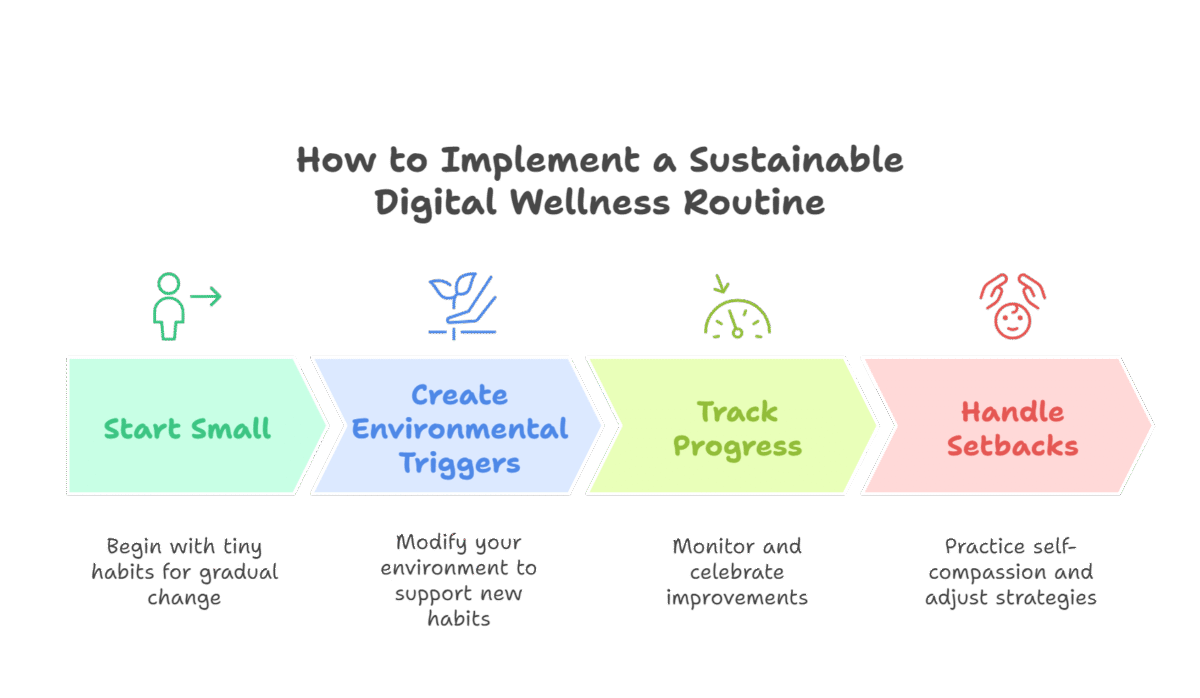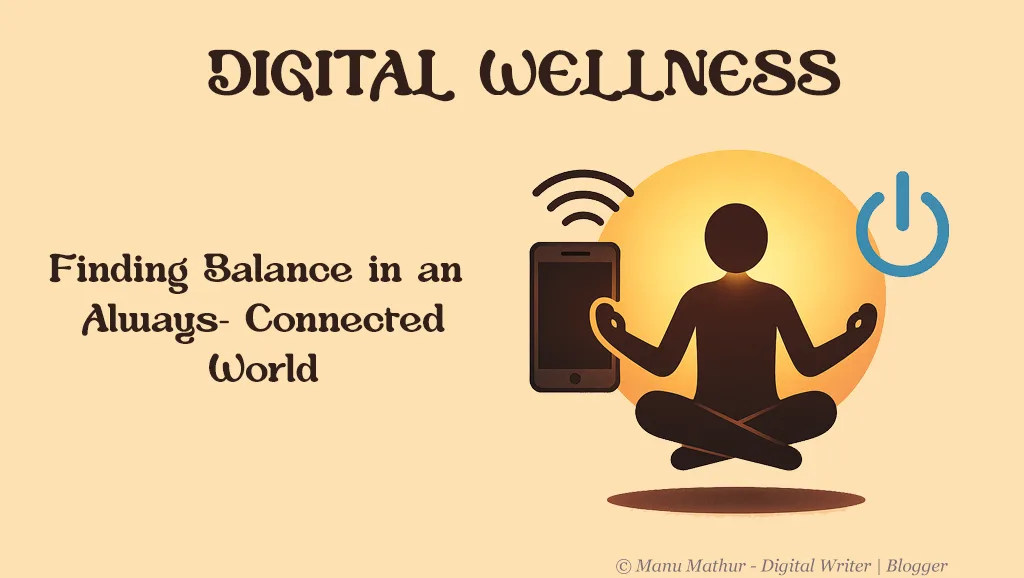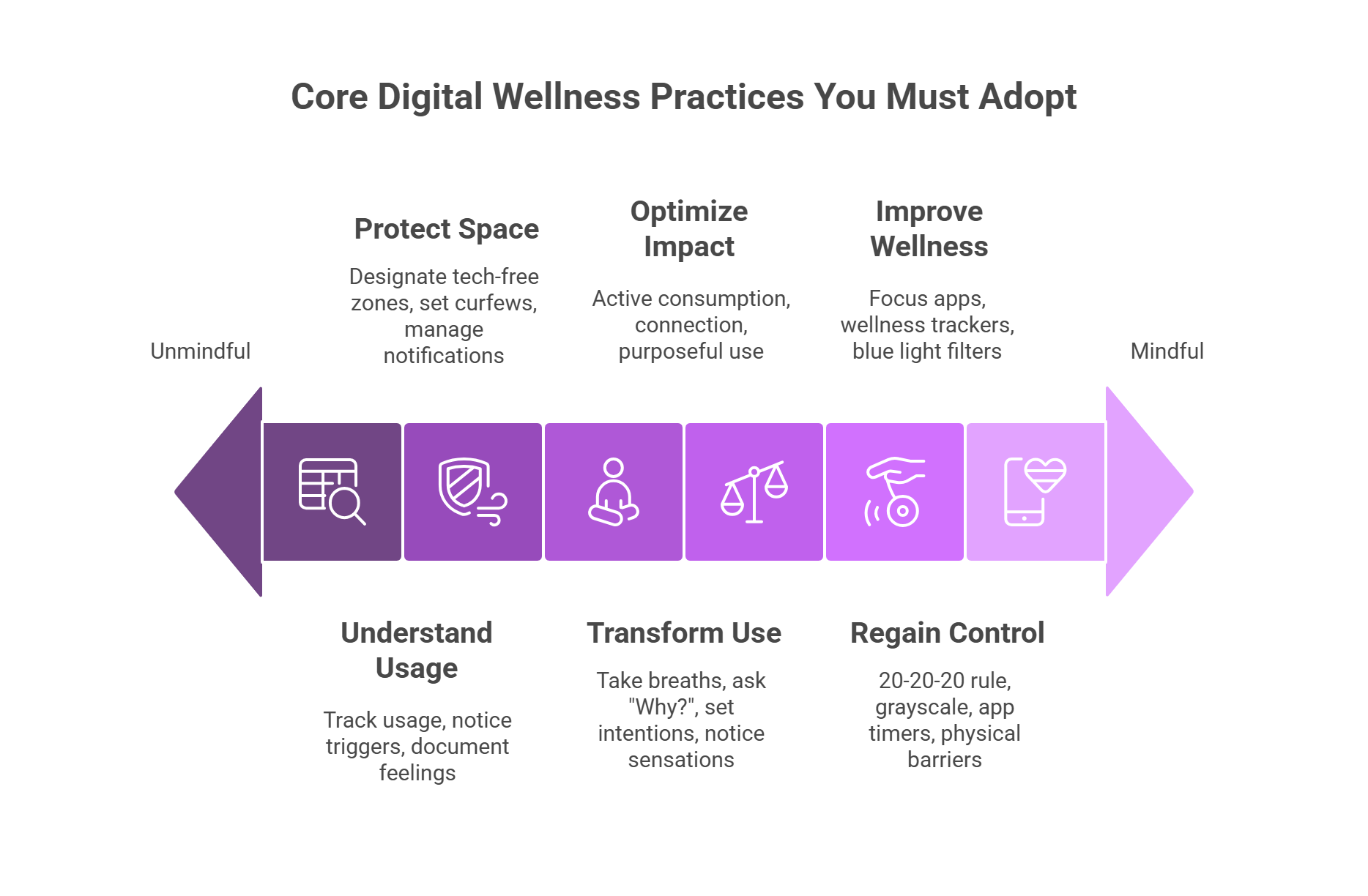In today’s hyperconnected world, our relationship with technology has become increasingly complex. The average Indian smartphone user spends over 5 hours daily on their device, while knowledge workers interact with digital platforms for 10+ hours per day. This constant digital immersion has created a new health concern: digital wellness.
Digital wellness refers to the balanced and mindful use of technology to enhance our lives without compromising mental health, physical wellbeing, or meaningful connections. As our dependencies on digital tools grow—from work communications to social interactions to entertainment—finding this balance has become not just desirable but essential.
“Technology should improve your life, not become your life.” – Kevin Kruse
Whether you’re experiencing symptoms of digital burnout, struggling with screen time management, or simply seeking a healthier relationship with your devices, this comprehensive blog post will provide actionable strategies to reclaim control and establish digital wellness practices that work in real life.
Why Digital Wellness Matters Now More Than Ever
The Growing Digital Dependency
The COVID-19 pandemic accelerated our digital transformation by several years. What began as temporary adaptations has become a permanent fixture in how we:
- Work (remote and hybrid arrangements)
- Learn (online education platforms)
- Shop (e-commerce and digital payments)
- Connect (video calls and social media)
- Entertain ourselves (streaming services and mobile games)
This shift has brought tremendous benefits—convenience, accessibility, and new opportunities. However, it has also introduced unprecedented challenges to our mental health and social connections, triggering a work-life imbalance.
The Hidden Costs of Constant Connectivity
Research from the Indian Journal of Psychiatry reveals concerning trends about our digital habits:
- Digital burnout: 64% of professionals report experiencing burnout from constant digital connectivity
- Sleep disruption: Blue light exposure from screens reduces melatonin production by up to 50%
- Attention fragmentation: The average person checks their phone 96 times daily, once every 10 minutes
- Social comparison: Heavy social media users report 43% higher rates of anxiety and depression
- Relationship strain: 73% of couples report technology interfering with their quality time
These statistics highlight why digital wellness isn’t just a trendy concept but a crucial life skill for the modern age.
Recognizing Digital Wellness Issues in Your Life
Signs You May Need a Digital Reset
Before implementing solutions, it’s important to recognize the warning signs of poor digital habits. You might need to reassess your relationship with technology if you experience:
- Phantom vibration syndrome – feeling your phone vibrate when it hasn’t
- Anxiety when separated from your device (nomophobia)
- Difficulty focusing on single tasks without checking notifications
- Comparing your life unfavorably to what you see on social media
- Sleep issues related to late-night scrolling
- Strained relationships due to device preoccupation
- Neck pain or eyestrain from extended screen time
Quick Self-Assessment
Answer these questions honestly:
- Do you reach for your phone within 5 minutes of waking up?
- Do you feel anxious when your battery is low or you’ve forgotten your charger?
- Do you struggle to complete tasks without digital distractions?
- Has someone close to you complained about your screen time?
- Do you check social media during meals or conversations?
If you answered “yes” to three or more questions, implementing digital wellness practices should be a priority.
Core Digital Wellness Practices for Better Tech-Life Balance
Creating Mindful Technology Habits
The foundation of digital wellness isn’t about rejecting technology but establishing intentional, mindful usage patterns. Here’s how to start:
1. Perform a Digital Audit
Before making changes, understand your current relationship with technology:
- Use screen time tracking apps to identify where your digital time goes
- Notice emotional triggers that prompt unnecessary device checking
- Document how different digital activities make you feel (energized vs. drained)
Try this: For one week, record each time you reach for your device, noting the trigger, the time spent, and how you felt afterward. Patterns will emerge that highlight your specific challenges.
2. Establish Digital Boundaries
Clear boundaries protect your mental space and physical health:
- Device-free zones: Designate certain areas (like the bedroom or dining table) as tech-free
- Digital curfews: Set a time each evening when screens go off (ideally 1-2 hours before bed)
- Notification management: Customize which alerts can interrupt your day
- Work-life separation: Create distinct profiles or devices for professional vs. personal use
Creating a Personalized Digital Boundary Plan
| Time of Day | Digital Boundary Strategy |
|---|---|
| Morning | Wait 30 minutes after waking before checking devices |
| Work Hours | Check email at designated times, not continuously |
| Breaks | Take tech-free breaks with physical movement |
| Evening | Implement a digital sunset 1-2 hours before bedtime |
| Weekends | Designate tech-free periods for deepened connections |
3. Practice Digital Mindfulness
Mindfulness—the practice of present-moment awareness without judgment—can transform your technology use:
- Take three deep breaths before unlocking your phone
- Ask, “Why am I reaching for my device right now?”
- Set intentions before browsing (“I will check social media for 10 minutes to connect with friends”)
- Notice physical sensations and emotions that arise during digital use
Mindful Technology Pause Practice
When you feel the urge to check your device, pause and:
- Take a deep breath
- Ask: “Is this necessary right now?”
- Consider: “What need am I trying to meet?”
- Decide: “Is there a better way to meet this need?”
This simple four-step process interrupts unconscious habits and reintroduces choice.
Managing Screen Time Effectively
Screen time management goes beyond simply reducing hours—it’s about optimizing the quality and impact of your digital engagement.
1. Quality Over Quantity
Not all screen time is created equal. Consider:
- Active vs. passive consumption: Creating content or learning is different from mindless scrolling
- Connection vs. comparison: Using technology to deepen relationships rather than foster envy
- Purpose vs. habit: Intentional use versus automatic checking
Research insight: Studies show that active, purposeful screen time doesn’t have the same negative mental health impacts as passive consumption.
2. Practical Screen Time Management Techniques
Implement these strategies to regain control:
- The 20-20-20 rule: Every 20 minutes, look at something 20 feet away for 20 seconds to reduce eye strain
- Grayscale mode: Changing your display to black and white reduces the dopamine hit from colorful apps
- App timers: Set daily limits for social media and entertainment applications
- Physical barriers: Store devices in another room during focused work or family time
- Digital nutrition labels: Evaluate apps based on their value-to-distraction ratio
“We don’t need to radically reject technology—we need to put it in its place.” — Cal Newport
3. Technology That Helps, Not Hinders
Ironically, certain digital tools can improve your digital wellness:
- Focus apps: Todoist, Clickup, and other applications block distracting websites during work sessions
- Wellness trackers: Devices like Apple Watch and Fitbit provide insights into your usage patterns
- Blue light filters: Night Shift, Dark Mode, or blue light glasses reduce sleep disruption
- Mindfulness applications: Calm or Breethe offer guided digital detox meditations
- Digital wellness settings: Most smartphones now include built-in screen time management tools
Digital Wellness in Specific Life Contexts
Digital Wellness at Work
Professional environments present unique digital wellness challenges, especially in remote and hybrid settings:
- Meeting fatigue: Excessive video calls create cognitive overload
- Always-on expectations: Work messages bleeding into personal time
- Task-switching costs: Digital interruptions reducing productivity by up to 40%
Strategies for Workplace Digital Wellness:
- Schedule focused work blocks with all notifications disabled
- Implement the “Pomodoro Technique” (25 minutes of focus followed by 5-minute breaks)
- Establish clear communication protocols with colleagues about response times
- Use email batching instead of real-time responses
- Take regular movement breaks away from screens
- Request “camera off” options for appropriate meetings to reduce video fatigue
Digital Wellness in Relationships and Family Life
Technology often competes for attention with our loved ones:
- 70% of parents admit that devices sometimes disrupt family interactions
- 45% of partners report feeling ignored due to their significant other’s device use
- Distracted parenting due to smartphone use affects child development and attachment
Creating a Family Digital Wellness Plan:
- Device-free meals: Establish regular technology-free dining experiences
- Tech-free activities: Designate times for fully present family engagement
- Modeling behavior: Demonstrate healthy technology use for children
- Digital agreements: Create age-appropriate family contracts for device use
- Joint digital detoxes: Plan regular periods where the entire family disconnects
Sample family media agreement points:
- No phones during meals or family activities
- Devices charge overnight in a common area, not bedrooms
- Screen-free hour before bedtime for everyone
- One tech-free day per month as a family
Digital Wellness for Mental Health
The relationship between digital habits and mental health is increasingly clear:
- Social media comparison triggers feelings of inadequacy
- Information overload contributes to anxiety and decision fatigue
- Constant connectivity prevents psychological recovery and restoration
Mental Health-Focused Digital Practices:
- Digital sabbaticals: Schedule regular breaks from social media (weekends, weeks, or months)
- Curate feeds carefully: Follow accounts that inspire rather than provoke comparison
- News consumption boundaries: Limit exposure to distressing world events
- Positive technology use: Leverage apps for meditation, journaling, or therapy
- Nature connection: Balance screen time with outdoor experiences
Implementing a Sustainable Digital Wellness Routine

Creating lasting change requires more than willpower—it demands systems and support.
Start Small: The 1% Improvement Approach
Rather than attempting a dramatic digital detox, begin with tiny habits:
- Wait 5 minutes before checking your phone in the morning
- Take a 10-minute walk without your phone daily
- Turn off notifications for your most distracting app
- Set a 30-minute screen-free period before bed
Each successful small change builds momentum for larger transformations.
Create Environmental Triggers
Your physical environment strongly influences digital habits:
- Charging stations: Keep devices charging away from bedrooms
- Physical barriers: Use boxes or drawers that hide devices during certain hours
- Visual reminders: Place books or hobby materials in spots where you typically use devices
- Alternative activities: Have non-digital options readily available for downtime
Track Your Progress and Celebrate Wins
Measuring improvements reinforces positive changes:
- Keep a digital wellness journal, noting improvements in focus, sleep, or relationships
- Use screen time reports to acknowledge weekly reductions
- Celebrate milestones like “one week of phone-free dinners.”
- Notice and document physical and mental benefits as they emerge
Handling Digital Wellness Setbacks
Perfect digital balance is impossible in today’s world. When you experience setbacks:
- Practice self-compassion rather than criticism
- Identify specific triggers that disrupted your routine
- Adjust your approach rather than abandoning efforts
- Remember that digital wellness is an ongoing practice, not a destination
Advanced Digital Wellness: Moving Beyond the Basics
If you’re ready to deepen your practice, consider these advanced strategies:
Dopamine Fasting
This practice involves temporarily abstaining from stimulating digital inputs to reset neurological sensitivity:
- Begin with 24 hours free from all digital stimulation
- Notice how your attention span and presence improve
- Gradually extend to longer periods (weekends or week-long breaks)
Digital Minimalism
Inspired by Cal Newport’s philosophy, digital minimalism involves:
- Removing all optional technologies for 30 days
- Carefully evaluating which tools add genuine value to your life
- Reintroducing only those that align with your core values
- Creating strict protocols for how and when you use them
Community-Based Digital Wellness
Leverage social support for lasting change:
- Join digital wellness challenges with friends or colleagues
- Form accountability partnerships for specific goals
- Participate in group digital detox retreats or programs
- Share successes and strategies within your community
The Bottom Line: Adopt Digital Wellness as a Lifelong Practice
Remember: Digital wellness isn’t a one-time achievement but an ongoing calibration.
As technology evolves and life circumstances change, your digital wellness strategies will need regular reassessment and adjustment. The goal isn’t perfection but intentionality—using technology as a tool that enhances your life rather than dominates it.
By implementing the strategies in this guide, you can cultivate a healthier relationship with digital devices that supports your physical health, mental wellbeing, productivity, and relationships.
Remember and please understand that your attention is your most valuable resource. Choosing where to direct it—and where to protect it from digital distractions—may be one of the most important decisions you make each day.
Your Next Digital Wellness Steps
Start your journey with these three actions:
- Complete the digital audit suggested earlier in this guide
- Implement one small boundary (like device-free meals) this week
- Share your digital wellness intentions with someone who can provide accountability
What digital wellness practice will you begin today?




